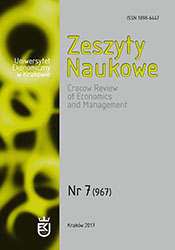Wpływ bazy kosmetycznej na uwalnianie kwasu usninowego
The Influence of Cosmetics Bases on the Release of Usnic Acid
Author(s): Małgorzata Kucia, Elżbieta SikoraSubject(s): Economy, Agriculture
Published by: Wydawnictwo Uniwersytetu Ekonomicznego w Krakowie
Keywords: usnic acid; base cosmetic; process of diffusion; release
Summary/Abstract: Usnic acid is a type of lichen acid which exhibits a broad spectrum of biological activity, functioning as an antimicrobial, an anti-inflammatory and a UV-filter. It is used as an active ingredient in herbal medicines and cosmetics products. Its influence as a cosmetics base, including through properties such as emulsion type or degree of internal phase droplet size, on the release of usnic acid, was studied. Two types (O/W, W/O) of usnic acid – loaded, stable emulsions with varying degrees of dispersion of the dispersed phase were obtained. The concentration of usnic acid in all of the formulations studied was 0.05% w/w. The formulations’ physicochemical properties, including stability, viscosity, pH and the droplet size of the dispersed phase, were evaluated. The kinesis of the usnic acid’s release was performed in a thermostatic diffusion chamber, at a temperature of T = 32°C, using dialysis membranes of regenerated cellulose. A mixture of phosphate buffer (PBS) and ethanol (EtOH), in 90/10, PBS/EtOH, volume ratio, was used as an acceptor solution. The concentration of released usnic acid was analyzed by UV-Vis spectrophotometer. The results showed that the O/W emulsions, as compared to W/O emulsions, are a much more effective means of administering usnic acid to the skin. After 24 hours, approx. 45% of the initial acid concentration penetrated into the acceptor solution from O/W emulsion, while from the W/O emulsion the released amount was about 18%.
Journal: Zeszyty Naukowe Uniwersytetu Ekonomicznego w Krakowie
- Issue Year: 967/2017
- Issue No: 7
- Page Range: 53-66
- Page Count: 14
- Language: Polish

